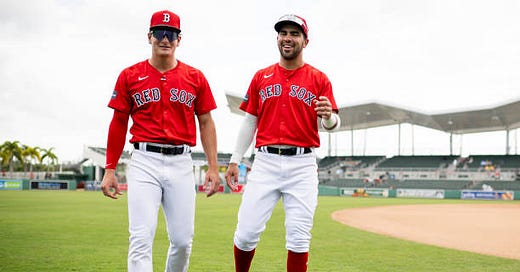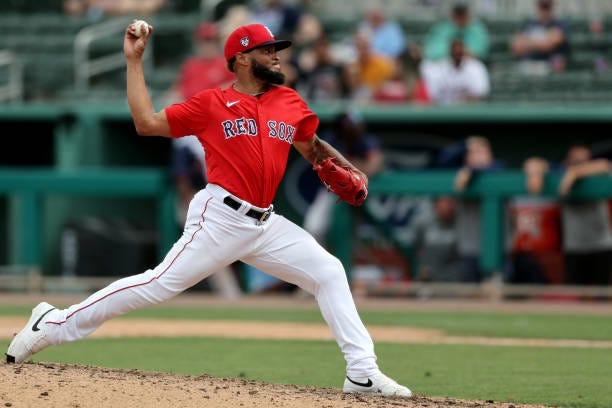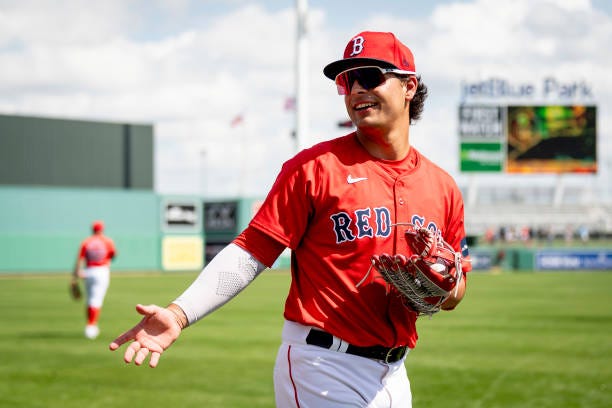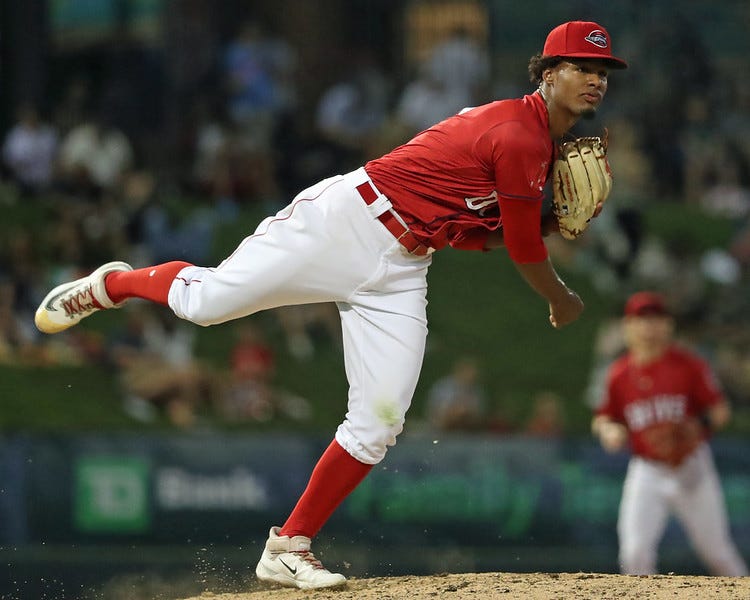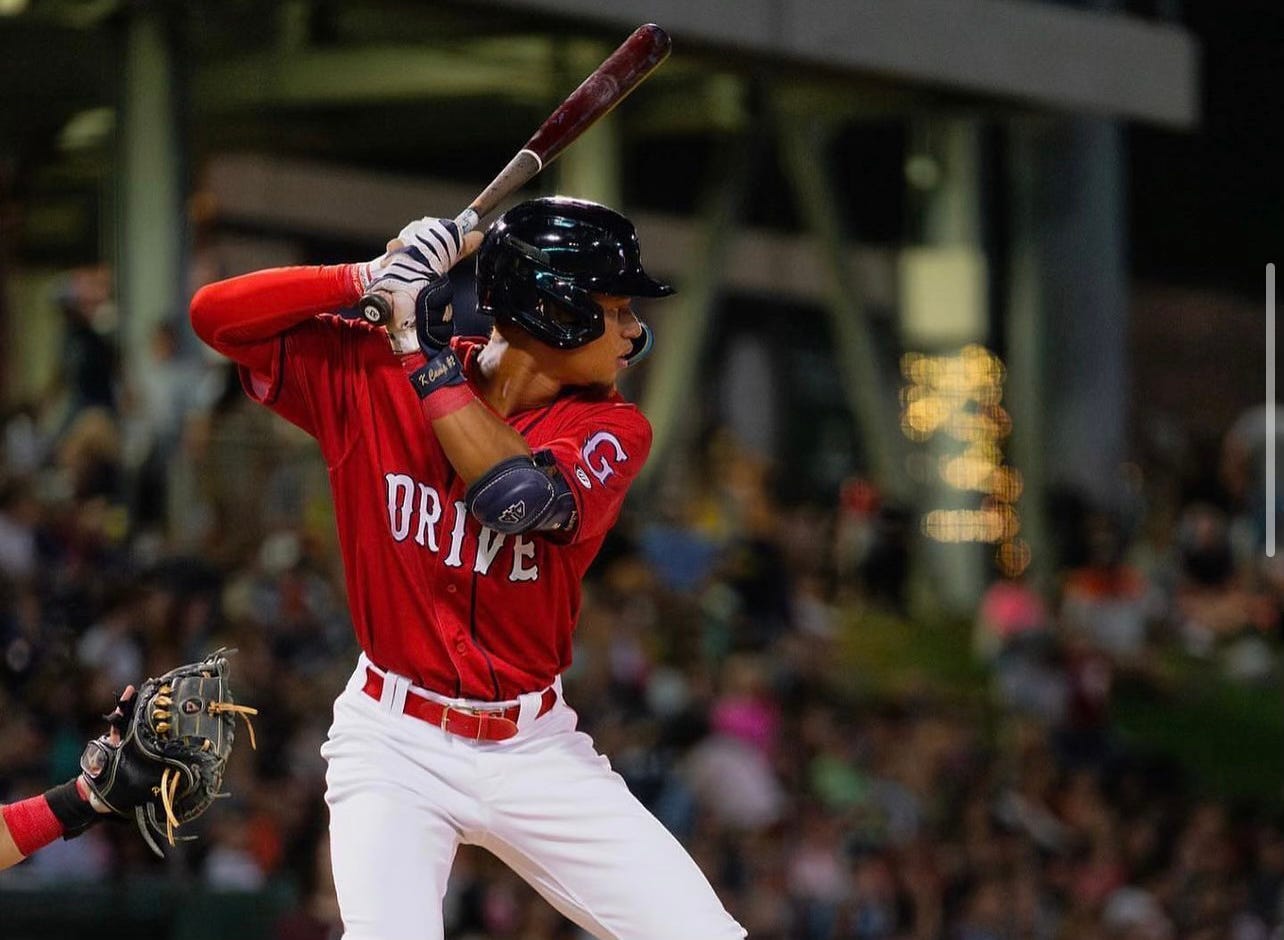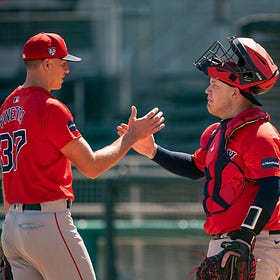Leandre: Top 30 Boston Red Sox prospects
As of the All-Star Break, here are my top 30+1 prospects in the Boston Red Sox organization.
Though lacking a true consensus ranking as a whole, the Boston Red Sox have one of the deepest and most interesting farm systems across Major League Baseball.
From a position player standpoint, they’re arguably a top-three farm system, with a pitching pipeline leaving some minor league experts wanting more.
That’s neither here nor there, as this ranking will focus solely on the top 30 prospects in the Red Sox organization, plus the “first one out.”
Many qualifiers went into my decision on where to rank certain players, including but not limited to age relative to their level, athletic ability, results, under-the-hood metrics, etc. I’m sure I will have a few prospects ranked comfortably distanced from where others have them.
We shall see.
With that, let’s get into my top 30+1 prospects.
First Man Out: RHP Jedixson Paez (Greenville)
It’s hard to pinpoint an exact archetype for Paez because he’s still so raw as a prospect, but the right-hander has some momentum building behind his strong 2024 campaign thus far.
Ultimately, what I like about the 20-year-old is his fearlessness in the strike zone despite lacking overpowering stuff.
That said, he has three decent pitches — fastball, curveball, changeup — but none of them should be defined as his go-to “out” pitch yet. However, I like his curveball the most and see that being his money-maker as he continues through the minor leagues.
Fluid delivery as well.
30. C/DH Nathan Hickey (Worcester)
Entering 2024, Hickey had met little resistance in terms of production. Despite being seen as a position-less prospect, the bat seemed poised to carry him to potentially a productive MLB career.
Not to say his Worcester numbers change things for me as far as long-term outlook, I just believe there are some real questions to be answered about his hit tool.
He was never projected to be a high-average hitter, but it’s grown clearer that he needs to be doing more damage at the plate to make the volume of strikeouts in his game not a fatal flaw.
29. INF Cutter Coffey (Greenville)
Though not similar builds, I like the comparison to Christopher Morel for Coffey because they’re both power-over-hit caliber players — quality of contact suggests positive regression with the hit tool — with suboptimal defensive projectability.
There’s a lot to like about the pop in Coffey’s bat, and he flashed why over a six-game span where he hit seven home runs from June 9 to June 15.
It feels like third base is where Coffey settles defensively, but his athleticism leaves some potential for a conversion to a corner outfield spot in the future. Wherever that defensive spot ends up being, however, he likely will be in the lineup solely for what he does with the stick.
28. RHP Luis Guerrero (Worcester)
Guerrero flew up Red Sox prospect rankings thanks to an electric fastball that landed him in the MLB Futures Game in Seattle last season.
That fastball is known to touch triple digits, which had fans expecting the right-hander to land on the big-league roster at some point in 2024. However, walks have held the 23-year-old back despite his 3.41 earned run average across 29 innings of work.
I do believe Guerrero’s velocity mixed with varying looks in pitch movement (fastball, splitter and slider) will create intrigue league-wide if not in Boston, but the command is shoddy at this stage of his development.
27. RHP Blake Wehunt (Greenville)
I like Wehunt a fair amount, though I think other outlets are generally lower on his ceiling.
At 6-foot-7 and 240 pounds, Wehunt offers a big body that allows him to get away with not having a high-velocity fastball (sits 93 to 94 mph) and his three-quarter arm slot gives him a more natural sweep to his breaking stuff.
He’s already huge, so I’m not sure what kind of development can be done to perhaps gain a mile or two on his heater, but he has three pitches that, developed well, could all be used situationally to get outs.
I like the comparison to Minnesota Twins right-hander Bailey Ober as another big-bodied individual who throws strikes and can miss bats without having electrifying stuff. In essence, projecting as a back-end starter or a bulk reliever.
26. LHP Hayden Mullins (Greenville)
Mullins has a good build with three pitches he can use to get outs.
While his fastball isn’t explosive, his slider shows potential to develop into a very effective pitch, especially since it has natural sweep to it. Should he add a sweeper or a cutter, pretty much anything else horizontal, it could give him three very good pitches.
I liken him more to left-handed relief depth, similar to what we’ve seen recently with Chris Murphy and Brandon Walter.
25. LHP Zach Penrod (Worcester)
It’s crazy to think that roughly one year ago, Penrod was pitching in the Independent League and now he’s knocking on the door of the majors at 27 years old.
His ascension has been something to behold, especially his development as a strikeout artist.
Perhaps given his age, Boston has been more aggressive with his promotions, seeing as the window for him to be a peak MLB contributor is probably closer to four years than somebody like Wehunt before him. As evidence, he threw only 35.1 innings in Double-A before his two starts and subsequent injury in Triple-A Worcester.
He has two breaking pitches and an average-ish fastball in his repertoire, but his money-maker will be his changeup and, hopefully, his cutter, though I’m not sold on the latter. In Boston, it feels like there’s always been a lefty with a change and/or cutter — Jon Lester, David Price, Eduardo Rodriguez, Martin Perez, etc. — and those two pitches were essential to their success.
It would probably be beneficial for the Red Sox to convert him to the bullpen at some point, just to maximize his stuff, but having five pitches provides some margin for error, especially in varying looks, even if only one or two projects to be legitimate “out” pitches.
24. OF Jhostynxon Garcia (Greenville)
Every year, the Red Sox have one or two prospects with monumental ascensions up the rankings and it appears this year’s is Jhostynxon (yos-TIN-son) Garcia.
Garcia wasn’t a bad prospect entering the year, but he certainly didn’t garner the steam he has presently at a near-45-homer pace over an MLB season.
He’s not the greatest athlete ever, certainly speed-wise, so a corner outfield spot seems more up his alley. But he’s got legit pop with room to grow muscle-wise into his body.
23. RHP Hunter Dobbins (Portland)
As far as players on this half of the top 30 are concerned, I find there’s a lot of intrigue in Dobbins.
To date, he’s not doing anything super flashy but quietly going out and consistently putting up solid effort after solid effort before a bit of a speed bump his last two times out.
His repertoire is toolsy — especially with a fastball that tops in the mid-to-upper 90s and a slider with movement along multiple planes, though I’d love to see the organization toy with him learning a cutter, giving him another pitch between his fastball and slider velocity-wise that can be effective against both sides of the platoon.
I like the comp to potential future teammate Josh Winckowski because I very much think the money is in the middle innings of relief for Dobbins long term, but someone salvageable as an effective starter.
22. LHP Connelly Early (Greenville)
Everything from build to mechanics to repertoire I like about Early, whom the Red Sox selected in the fifth round — four rounds after his collegiate battery mate, Kyle Teel.
He doesn’t have an overpowering fastball, which is largely consistent with most Red Sox starting pitching prospects, but I love his changeup and the ability of his cutter and fastball to play off each other in the future.
I doubt he projects any higher than a back-end starter without a one- or two-mile uptick in fastball velocity, but I see a productive big-league career in this lefty’s future.
21. SS Franklin Arias (FCL Red Sox)
It’s tough to project someone so far away from MLB consideration, especially compounding that with somebody born in 2005 like Arias.
He has plenty of room to grow as a player, especially from a power standpoint. That said, he presently is a strong kid with athleticism and the arm to stick at shortstop long term.
If I had to liken him to somebody right now, Jhonny Peralta comes to mind. Steady offensive production, OK defender with enough pop to ambush you and run into 15-18 a season.
Again, he’s a baby as far as his development as a pro is concerned, so a lot can change over time, but right now he’s someone maybe a year away from generating real steam as a prospect.
20. 2B Nick Yorke (Worcester)
It felt like Boston promoted Yorke to Triple-A more as a “sink or swim” scenario than based on actual production, but he’s responded since his promotion.
I will say, Polar Park is known for helping boost offensive numbers, so look at the production with somewhat tempered expectations. However, the second baseman remains a steady defender with added versatility of left field.
I think there’s an outside chance Yorke makes his big-league debut in the coming weeks, but I also wouldn’t be shocked should that be for another organization.
He’s a decent bat with a steady glove, so his ceiling is fringe everyday player in my estimation with some give-or-take in production based on BABIP luck or fortuitous ballpark dimensions to the pull-side. While he does have power to all fields, I don’t know how well that’ll translate to his future as an MLB contributor.
19. RHP Wikelman González (Portland)
I’m begging the right-hander to develop command, because he has probably the liveliest arm in the entire organization save for Guerrero.
I think the idea of him as a starter is dead, but that doesn’t mean he can’t become a multi-inning reliever with potential to develop into a high-leverage arm.
FanGraphs’ preseason report on the 22-year-old is spot on: Future 60-grade fastball, changeup and slider with 40-grade command. To me, that screams effectively wild reliever.
Obviously, having good stuff doesn’t always equal good results or a good career. Red Sox fans don’t have to look too far back to find Darwinzon Hernandez. That said, fans have also seen the likes of Josh Taylor, Matt Barnes and, the extreme example, Craig Kimbrel over recent years.
18. OF Allan Castro (Greenville)
Castro has a knack for working counts and forcing opposing pitchers to get him out by challenging him with strikes. For that, I think he has a legitimate future because plate discipline can carry you when your BABIP fails you.
This year, he’s hovered around a .360 OBP. While strikeouts have crept back up to pre-2023 percentages, it’s not such an alarmingly high number to make you question if when he takes another leap into Double-A he’s doomed.
Castro strikes me more as a future fourth outfielder, with potential to crack some lesser everyday lineups given his constant platoon advantage as a switch hitter.
17. UTIL Matthew Lugo (Worcester)
Lugo has re-emerged as a legitimate prospect in this farm system with an excellent 43-game run in Double-A Portland that led to a promotion to Triple-A Worcester.
While he hasn’t met the same success thus far with the WooSox, he continues doing damage when he is making contact.
I liken him a bit to Adam Duvall, who is a fellow power-over-hit tool bat with some positional versatility in the outfield. Though, for those who might not remember, Duvall also had third base in his bag of tricks coming up … as does Lugo.
I think he can have a productive big-league career, but it’ll be contingent on the stability of his power stroke.
16. RHP Yordanny Monegro (Greenville)
Monegro is definitely a case of development not always being linear, even as a minor-leaguer.
Battling injuries this season kept him out of action, really, until June. Since returning to High-A Greenville, he has struggled with his command and keeping the ball in the yard.
However, I really like this kid’s stuff and just the intensity and swagger he pitches with. I recognize that No. 16 may be a little ambitious for the right-hander, but I really think he’s someone worth keeping intense eyes on as he continues to progress through the system.
If he can add a tick or two to his fastball, or a little more sweep to his breaking ball, he’s going to end up with two plus-pitches and/or an elite secondary offering, which would give him a floor of multi-inning reliever.
15. 1B Blaze Jordan (Portland)
Jordan has hopped around Red Sox prospect rankings since he was drafted in 2020, but he has settled in at No. 15 for me because he appears to have figured out how to do damage on all sorts of pitches.
I always viewed him as a power-over-hit prospect, but it appears he’s more of a hit-over-power player with the home run ball in his back pocket. He shows a willingness to hit the ball to all fields and still has the power for some majestic home runs.
The proof is in the pudding with his improvements as a player, though. He cut weight in the winter and came into camp in tremendous shape. The work ethic he displayed all winter paid dividends immediately, but more so after missing a month with an injury. Since returning from the injured list, he hasn’t missed a beat.
I view him more as a lower-third of the order hitter, sort of like what the Red Sox were doing early in Bobby Dalbec’s career, hitting him seventh to provide some thump at the bottom of the lineup. Jordan, however, I view more as a Ty France-caliber bat.
14. INF Eddinson Paulino (Portland)
Paulino is an intriguing prospect, but I don’t know what to expect a career for his skillset to look like.
He has some sneaky power, but not in the sense that you can expect more than maybe 10 to 12 in a given year for him. I like his positional versatility on the infield and he even got some work in as an outfielder in recent seasons.
I see him more as a minor-league Brock Holt; sort of a Swiss Army knife with average-ish skills across the board but can run into a decent peak in the correct role for a club.
13. RHP Richard Fitts (Worcester)
It seems Ball 4 is Fitts’ kryptonite this year, as is often the case in pro baseball.
In six outings with one or fewer free passes, he has a 3.34 ERA; in eight with two or more walks, his ERA is 4.75.
I think Fitts has a ceiling rounding out rotations with his repertoire highlighted by a slider and mid-90s fastball. If he can develop his changeup into a legitimate whiff-getter, that might save him as a starter and give him a higher ceiling than currently projected.
However, I could see his best days coming in middle relief to get more out of his stuff.
12. C Johanfran Garcia (Salem, IL)
I’m buying the helium behind the Red Sox catching prospect with gusto. While he unfortunately hurt his knee and has been out since late April, it doesn’t change the incremental improvements he made entering the 2024 season.
How I see it? If you can hit homers in Salem, you probably have some serious pop in the bat. The 19-year-old had two homers and five doubles in 14 games this season before hurting his leg.
He and his brother (No. 24 on this list) made names for themselves this season and I think that’s just the beginning. This catching prospect has the athleticism to stick at catcher, with a weakness being something that might not matter anymore in a couple of seasons (framing).
11. RHP Elmer Rodriguez-Cruz (Salem)
If any of the Red Sox prospects outside the top 10 were to be top 100 nationally next season, Elmer Rodriguez-Cruz would be my pick.
I like his pitch mix a lot, and feel as though there’s enough separation in velocity for deception even though he sits in the 92 to 94 mph range on the heater.
While he still is refining his command, the righty has seen his strikeouts go up and walks go down from last season. He’s also proficient at keeping the ball in the ballpark, which speaks some to his home ballpark in Salem but also his ability to stay away from the opponent’s barrel.
Currently listed at 6-foot-3 and 160 pounds, there’s definitely room for muscle on Rodriguez-Cruz’s frame, and adding that could also potentially contribute to a velocity increase.
If he can get that fastball to sit 94 to 96 and top at 97 to 98, the Red Sox can add another starter to the list of exciting members of potentially the next great young core in Boston.
10. RHP David Sandlin (Greenville)
Given where the Red Sox were from a pitching prospect standpoint when Sandlin came over from Kansas City, he jumped from near the Royals’ No. 30 prospect to the top 10 in Boston’s system.
Injuries have hampered what figured to be a big year for Sandlin, but he’s got legitimate mid-rotation potential. It’s just a matter of building upon his ever-developing arsenal and gaining feel for each of his secondaries.
9. IF Chase Meidroth (Worcester)
If Meidroth had a 15-plus-year career, I wouldn’t be shocked at all.
Given the lack of stability Boston has gotten out of the second base position, as well as the best defensive alignment featuring Ceddanne Rafaela in center field as opposed to shortstop, I’m shocked Meidroth hasn’t been added to the 40-man roster and subsequently the MLB roster.
Meidroth has elite command of his bat as well as command of the strike zone. Over the past calendar year, he’s walked more times than he’s struck out and is hitting .280, more or less.
Could he end up being Nick Madrigal at the MLB level? For sure, especially with the advancements in scouting. Could he also end up threatening for the battling title for the next decade? Also yes.
8. SS Nazzan Zanetello (Salem)
Zanetello is also a super young, super raw prospect in the Sox organization.
Fans got a taste of what the Red Sox saw in him when they selected him in the second round last summer, but this year it’s really starting to shine through. He got bigger since the end of last year and appears to have refined his swing.
A lot of people liken his swing, and seemingly effortless extra-base pop to Rangers second baseman Marcus Semien. I see the similarities in his swing, but I’m not sure he has a 40-homer season in him.
I think his ceiling is a viable MLB contributor with an absolute ceiling of fringe All-Star. He’s a really solid ballplayer.
7. SS Yoeilin Cespedes (Salem)
Similar to Arias, it’s hard to truly assess the ceiling of Yoeilin Cespedes.
However, he’s got the most helium of the Tier 2 or 3 prospects in the organization.
There’s some question about whether he sticks at shortstop long term or converts to a corner outfield spot or maybe second base. However, he’s a really strong kid with defensive upside and a lot of boom in his bat.
He has a violent swing and generates a ton of loud contact with it. Of the top 10, he’s the one I’m most curious to see ranked nationally in a year.
6. RHP Luis Perales (Portland, IL)
Before Perales got hurt, I had him in my top five. However, given the nature of his injury — needing Tommy John Surgery — there’s a real chance he ends up not pitching again until late-2025, maybe even Spring Training of 2026.
Baseball America had the right-hander at No. 4 before his injury. In fact, he was in the top 60 among all of prospects. His velocity went up another notch, and he sustained it, with improved secondaries and even more swing-and-miss. It’s really a shame he got hurt.
That all aside, even as Red Sox fans endure the rewards of patience — Tanner Houck and Kutter Crawford — and the anguish of inconsistent progression in development with Brayan Bello, it’s nice to now have another young starting pitcher emerge.
I think he has mid-rotation upside with an absolute ceiling as a low-end No. 2 starter.
5. OF/2B Kristian Campbell (Portland)
This kid rakes, man.
I know there is some parity in league-wide viewership of how he’s become so successful, including belief he’s cheating for certain pitches thus leaving himself vulnerable to others.
He hits the daylights out of the ball, though. There are some questions about where he ends up defensively, but his bat will play. I have no doubt in my mind he’s got a future as an impact MLB bat.
His swing isn’t sexy. In fact, it’s drawn some ire from people for not being the most aesthetically pleasing ever. However, Hunter Pence didn’t have a pretty swing either, and he was an All-Star and World Series Champion.
4. OF Miguel Bleis (Greenville)
Bleis has so much grey area between his floor and ceiling as a player.
People see the flare and the accessories and see him being a future superstar a la Ronald Acuna Jr. — though I think that had more to do with the neon yellow sleeve we’ve seen him wear than anything. That said, I think there’s a real argument to be made that he can develop into somebody similar to Mike Cameron.
Even though he doesn’t have elite speed, he’s a ball hawk in center field and a smart baserunner. He doesn’t have consistent jaw-dropping power but he can run into a ball with the best of them in MiLB. If he finished his career with a moderately full trophy shelf, I wouldn’t be shocked.
That said, he’s still super raw, and hasn’t yet shown out in his limited sample for High-A Greenville.
3. OF Roman Anthony (Portland)
Anthony coming in third has less to do with him than it has to do with how I feel about the two players ahead of him.
I think the Red Sox have a future All-Star and potential MVP candidate in each of their top three prospects. But, in my view, each of the three have similar ceilings so the deciding factor for came down to positional value mixed with my perceived floor for each player.
Anthony has a legitimate offensive profile, displaying willingness to hit the ball the other way to take his base hits and picking his spots to sell out for power.
I view him more as a corner outfielder, especially given the Red Sox’ current outfield landscape of Jarren Duran and Ceddanne Rafaela both playing a proficient center field defensively.
2. SS Marcelo Mayer (Portland)
Mayer has the potential to be an MVP candidate with his hit tool and steadiness as a defender of shortstop.
Even though I rank him second, there’s a real argument — likely the right one — that he is the most important prospect in the organization. I can’t imagine the mental burden that would have on me, but Mayer performs with no inclination that it weighs him down.
He, along with Anthony and Kyle Teel, are not long for Portland. It’s hard to imagine the MLB Trade Deadline comes and goes without all of them having already made their Worcester debuts.
Mayer has a proficiency for extra bases, whether it be shooting the ball to left for doubles or turning on inside pitches for line-drive homers. He is an exit velocity darling with results to go with it.
They’ve tried him at third base a little bit as well, but I firmly believe he will be the long-term shortstop of the Boston Red Sox.
1. C Kyle Teel (Portland)
This comparison stays following Teel from his draft day, but it genuinely feels the most appropriate one, comparing Teel to Hall of Famer Joe Mauer.
It feels taboo to compare someone with no MLB service time to a Hall of Famer, but Teel possesses a tremendous hit tool with developing power to all fields.
However, the defense is what separates Teel from his peers. He controls the running game amongst some of the best in minor-league baseball and has shown real strike-stealing ability dating back to his college days with the University of Virginia.
I know Teel ranking first is going to seem like a massive reach, despite him being part of the consensus “Big 3.” But given the difficulty in finding elite catching prospects, mixed with his seeming lack of exploitable shortcomings, I feel most confident in Teel being a perennial All-Star player, at least from a value standpoint.
Red Sox release veteran catcher after spending all season on injured list
The Red Sox released veteran catcher Roberto Perez on Tuesday, according to the transaction log. Perez had been on the WooSox’ 60-day injured list while working out in Fort Myers. There had been speculation he would have come off the IL in June and be assigned to Triple-A Worcester.
Follow Jordan on X @JordanLeandre55
For additional Red Sox and Major League Baseball content, follow Beyond the Monster: Boston Red Sox on X BeyondtheMnstr


